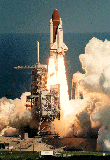
Note: Click on Solar System Exploration: Galileo Legacy Site (NASA-JPL) to get this image at its highest resolution.
Liftoff of STS-34 Atlantis, carring the Galileo spacecraft and its Inertial Upper Stage (IUS) booster on October 18, 1989 at 12:35 p.m. EDT. P-35036BC
The shuttle mission was commanded by Donald E. Williams and piloted by Michael J. McCulley. Mission specialists were Shannon W. Lucid, Franklin W. Chang-Diaz, and Ellen S. Baker.
NASA policy in the early 1980's was to launch all spacecraft from the shuttle, unlike earlier, expendable-rocket-launched interplanetary missions such as the Voyager Mission (which visited Jupiter, Saturn, Uranus and Neptune).
Initially, it seemed as though Galileo's launch was fated to be delayed. Worries over whether Hurricane Hugo would come onshore at the Kennedy Space Center mounted until, at the last moment, the destructive force of the storm swept north of the launch site, allowing engineers to relax. Then, the day before the rescheduled launch, a 7.1 earthquake, centered just 25 kilometers (15 miles) south of Sunnyvale, California, caused evacuation of the Inertial Upper Stage control center there, which was crucial to mission operations. The control center crew recovered as the night progressed, allowing the countdown to continue.
Since the shuttle needs to have a daylight landing opportunity at the trans-Atlantic landing abort sites, and since there are performance constraints on Galileo's inertial upper stage, spacecraft liftoff could only occur during certain periods of time. The launch opportunity opened on Oct. 12, 1989 for a 10-minute period. The launch window then grew each day, reaching a maximum of 47 minutes on Nov. 2. The window then decreased each day through the remainder of the launch opportunity, which ended on November 21, 1995.
Because Galileo used a VEEGA (for Venus-Earth-Earth Gravity Assist) trajectory to fly to Jupiter (rather than a direct trajectory), its launch opportunities did not repeat at regular intervals the way direct trajectories do. This is because there are many ways to combine a launch from Earth with one Venus and two Earth flybys to get to Jupiter. The next three VEEGA opportunities to Jupiter after the one Galileo used occurred in November 1989 and May/June 1991. There were actually two different opportunities in the May/June 1991 time period.
Next slide: Deployment of Galileo and the IUS
Back to: Galileo To Jupiter
Link to: Solar System Exploration: Galileo Legacy Site (NASA - JPL)
Updated: July 15 '96
Best seen with MS Internet Explorer.
Back: ARVAL - Image Gallery
Messages: